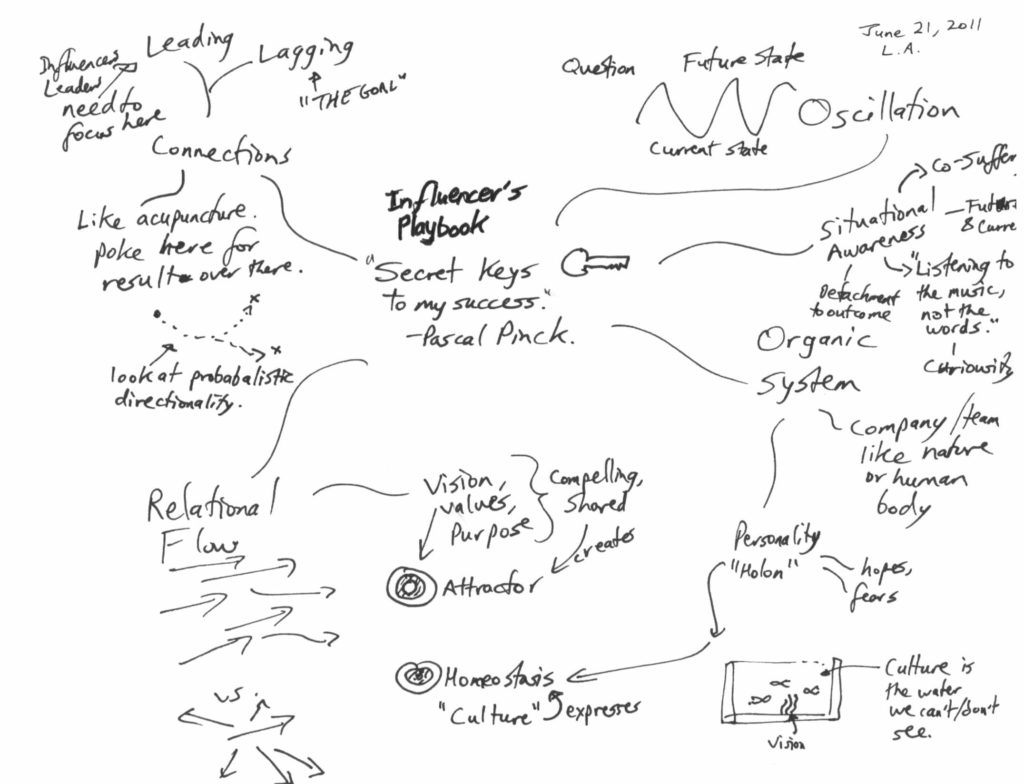(Joint post with Pascal Pink)
I was extremely privileged to share a day with Pascal Pinck and learn his “playbook” as a powerful influencer. His lessons span mental models, coaching stance and tools for effecting change.  The infographic above expresses the key concepts – I will tie them together below.
The infographic above expresses the key concepts – I will tie them together below.
Situational Awareness (Stance)
The place to start as an influencer is as a “co-sufferer”: to approach a system with deep respect and humility. Siraj Sirajuddin refers to this as “supplication”. I have experienced that this is the single most critical ingredient for success. More on this in coming posts. When connecting with a system is essential to “Listen to the music, not the words” (Quote from Gerry Weinberg). This is because language may transmit conflicted sentiments and channel residue from past traumas, whereas the underlying spirit knows what is needed to create a resonant future. One expression of respect for a system is detachment from the outcome – accepting the will of a system to choose it’s own destiny. Pascal says this has gotten much easier for him since he accepted the reality that systems will not generally let influencers move them in a direction that is counter to their underlying orientation or DNA anyway.
Think of the organization as a person
An organization is a biological, organic system. We can use the metaphor of a human body as way to think about making interventions. We may also think of a system as having a personality: what are it’s hopes, fears, dreams and ambitions? See KrisMap for a workshop to explore this. Homeostasis in the human body is a very powerful force that keeps us healthy. In systems, the status quo is expressed through the invisible and powerful force of organizational culture. It’s like the water we are swimming in that we can’t see. What can draw us away from homeostasis?
Compelling Shared Vision is a Critical Attractor
A shared vision is not enough. It needs to be a compelling shared vision to create a strong enough attractor to shift away from the status quo. Values and purpose intertwine with the vision to create a powerful attractor. A particularly powerful vision is that of a breakthrough organizational culture. One purpose of compelling shared vision is to help induce relational flow so that the parts of the system are constantly aligning and self-synchronizing, which allow multiple sources of energy to pull in the same direction.
Intervene with Leading Indicators
One problem with organizations that focus (at a strategic level) on goals is that outcomes are by definition lagging indicators. Influencers get better results by focusing on the leading indicators. A simple example of this is whether to focus on team trust, alignment, and communication patterns (leading indicators) or budget variance, “lessons learned” and “best practices” (lagging indicators). Pascal uses the metaphor of acupuncture where you poke the body in one place to get a result in another. For this to work we actually have to have some sort of model of the connections between things. In line with Cynefin framework for complex environments we can’t fully understand situations but can conceptualize “probabilistic directionality” to reason about interventions.
Oscillate between future and current state
A good influencer will oscillate between current state and future state. We need to connect with the current state to have empathy for the system and we need to connect with the future state to provide direction and sense mismatches. It also provides a great source of questions. Pascal recommends The Three Laws of Performance by Logan and Zaffron as an excellent way to develop a deeper understanding of this topic
Acknowledgements
I would like to thank Pascal for inviting me to LA last year to experience one of the most insightful days of my life and for sharing the secrets of his success. And then for co-writing this post with me. I would like to thank Siraj Sirajuddin who developed or co-developed several of the ideas expressed in this post.


